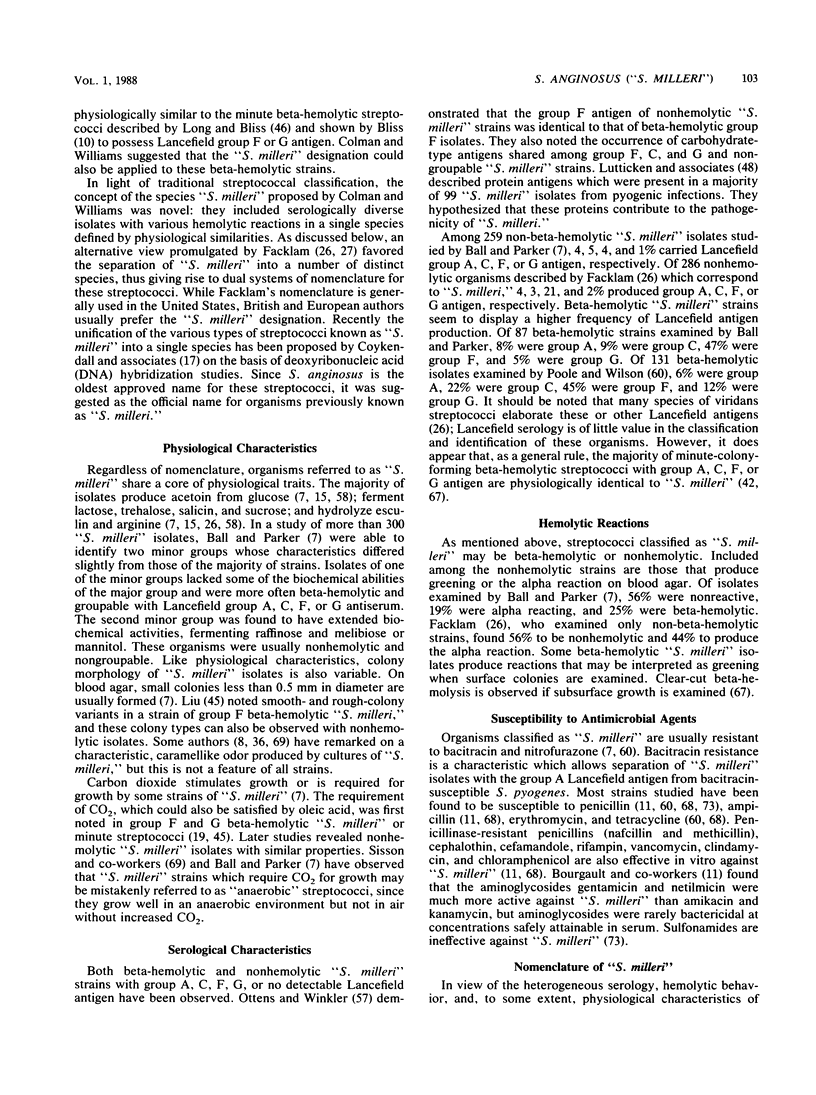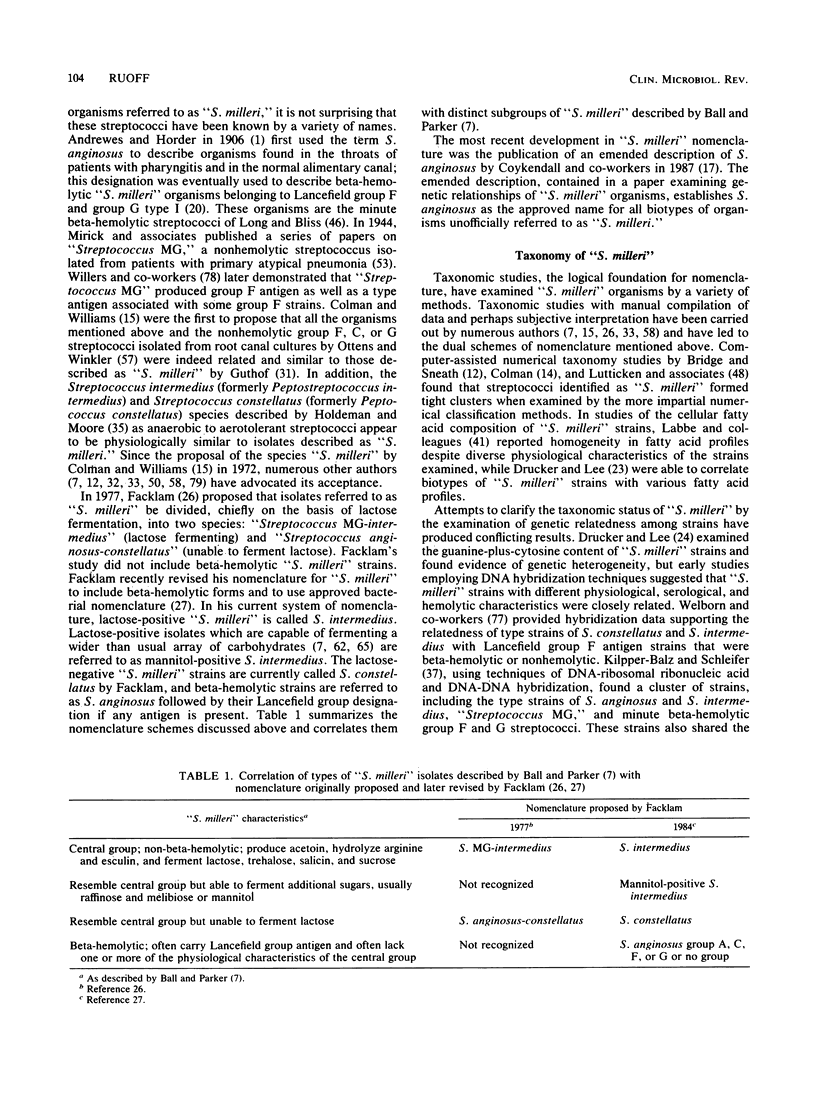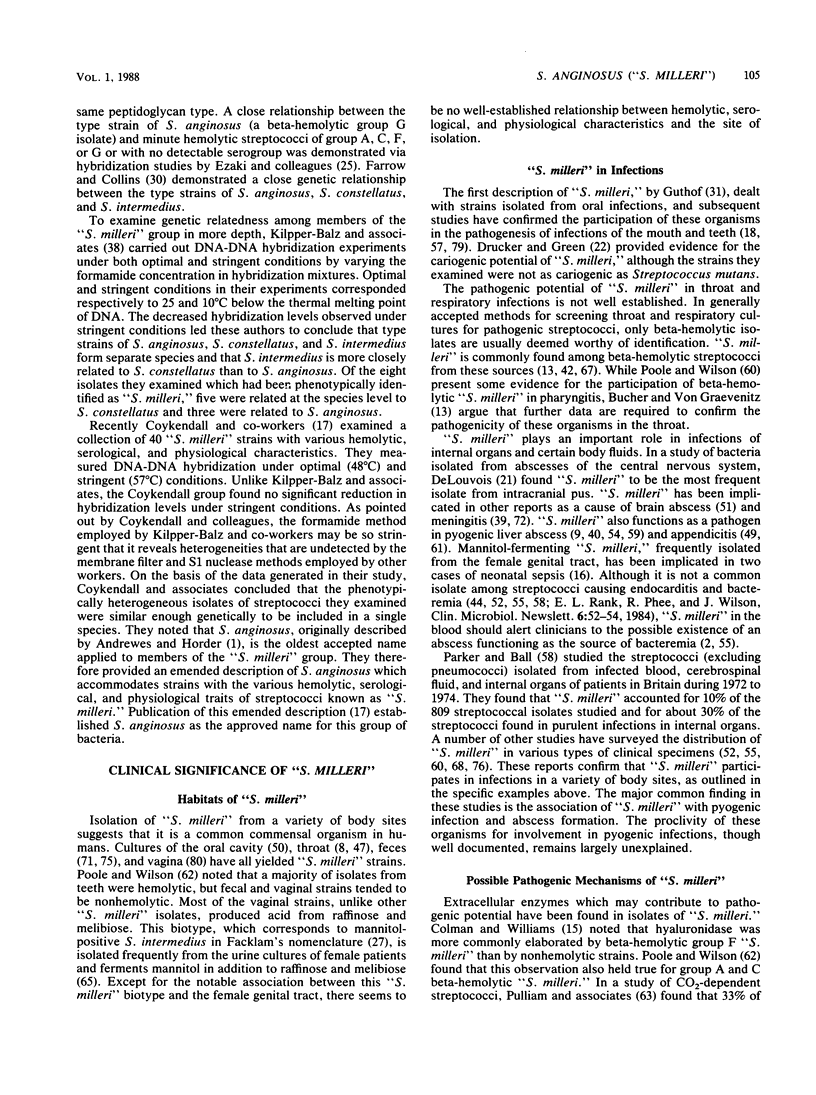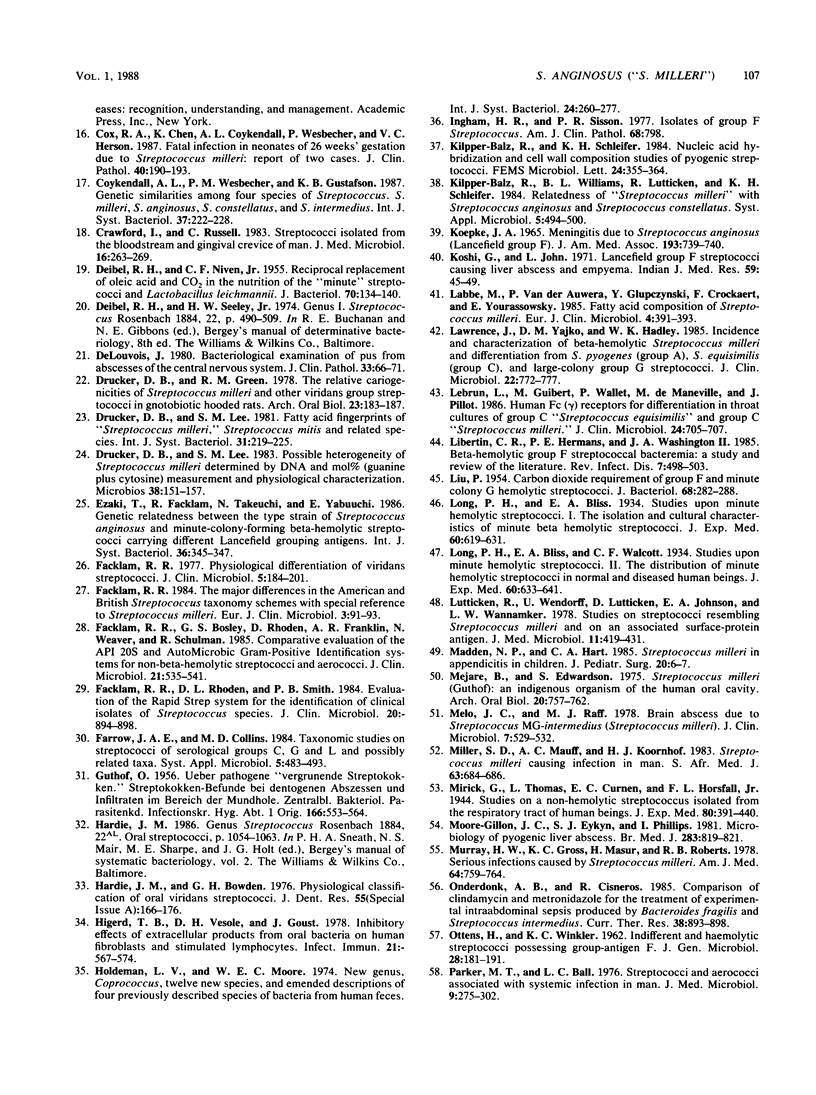Abstract
"Streptococcus milleri" is an unofficial name that has been applied to a group of streptococci which, although basically similar, show various hemolytic, serological, and physiological characteristics. The species name Streptococcus anginosus has recently been recognized as the approved name for these organisms. Streptococci known as "S. milleri" have been implicated as etiologic agents in a variety of serious purulent infections, but because of their heterogeneous characteristics, these organisms may be unrecognized or misidentified by clinical laboratorians. This review describes the bacteriological aspects of organisms known as "S. milleri," their clinical significance, and the problems encountered with their identification in the clinical laboratory.
Full text
PDF






Selected References
These references are in PubMed. This may not be the complete list of references from this article.
- Appelbaum P. C., Chaurushiya P. S., Jacobs M. R., Duffett A. Evaluation of the rapid strep system for species identification of streptococci. J Clin Microbiol. 1984 May;19(5):588–591. doi: 10.1128/jcm.19.5.588-591.1984. [DOI] [PMC free article] [PubMed] [Google Scholar]
- Appelbaum P. C., Jacobs M. R., Heald J. I., Palko W. M., Duffett A., Crist R., Naugle P. A. Comparative evaluation of the API 20S system and the automicrobic system gram-positive identification card for species identification of streptococci. J Clin Microbiol. 1984 Feb;19(2):164–168. doi: 10.1128/jcm.19.2.164-168.1984. [DOI] [PMC free article] [PubMed] [Google Scholar]
- Arala-Chaves M. P., Higerd T. B., Porto M. T., Munoz J., Goust J. M., Fudenberg H. H., Loadholt C. B. Evidence for the synthesis and release of strongly immunosuppressive, noncytotoxic substances by Streptococcus intermedius. J Clin Invest. 1979 Oct;64(4):871–883. doi: 10.1172/JCI109553. [DOI] [PMC free article] [PubMed] [Google Scholar]
- Arala-Chaves M. P., Porto M. T., Arnaud P., Saraiva M. J., Geada H., Patrick C. C., Fudenberg H. H. Fractionation and characterization of the immunosuppressive substance in crude extracellular products released by Streptococcus intermedius. J Clin Invest. 1981 Jul;68(1):294–302. doi: 10.1172/JCI110247. [DOI] [PMC free article] [PubMed] [Google Scholar]
- Ball L. C., Parker M. T. The cultural and biochemical characters of Streptococcus milleri strains isolated from human sources. J Hyg (Lond) 1979 Feb;82(1):63–78. doi: 10.1017/s002217240002547x. [DOI] [PMC free article] [PubMed] [Google Scholar]
- Bannatyne R. M., Randall C. Ecology of 350 isolates of group F Streptococcus. Am J Clin Pathol. 1977 Feb;67(2):184–186. doi: 10.1093/ajcp/67.2.184. [DOI] [PubMed] [Google Scholar]
- Bateman N. T., Eykyn S. J., Phillips I. Pyogenic liver abscess caused by Streptococcus milleri. Lancet. 1975 Mar 22;1(7908):657–659. doi: 10.1016/s0140-6736(75)91760-2. [DOI] [PubMed] [Google Scholar]
- Bliss E. A. Studies upon Minute Hemolytic Streptococci: III. Serological Differentiation. J Bacteriol. 1937 Jun;33(6):625–642. doi: 10.1128/jb.33.6.625-642.1937. [DOI] [PMC free article] [PubMed] [Google Scholar]
- Bourgault A. M., Wilson W. R., Washington J. A., 2nd Antimicrobial susceptibilities of species of viridans streptococci. J Infect Dis. 1979 Sep;140(3):316–321. doi: 10.1093/infdis/140.3.316. [DOI] [PubMed] [Google Scholar]
- Bridge P. D., Sneath P. H. Numerical taxonomy of Streptococcus. J Gen Microbiol. 1983 Mar;129(3):565–597. doi: 10.1099/00221287-129-3-565. [DOI] [PubMed] [Google Scholar]
- Bucher C., von Graevenitz A. Differentiation in throat cultures of group C and G streptococci from Streptococcus milleri with identical antigens. Eur J Clin Microbiol. 1984 Feb;3(1):44–45. doi: 10.1007/BF02032818. [DOI] [PubMed] [Google Scholar]
- Colman G. The application of computers to the classification of streptococci. J Gen Microbiol. 1968 Jan;50(1):149–158. doi: 10.1099/00221287-50-1-149. [DOI] [PubMed] [Google Scholar]
- Cox R. A., Chen K., Coykendall A. L., Wesbecher P., Herson V. C. Fatal infection in neonates of 26 weeks' gestation due to Streptococcus milleri: report of two cases. J Clin Pathol. 1987 Feb;40(2):190–193. doi: 10.1136/jcp.40.2.190. [DOI] [PMC free article] [PubMed] [Google Scholar]
- Crawford I., Russell C. Streptococci isolated from the bloodstream and gingival crevice of man. J Med Microbiol. 1983 Aug;16(3):263–269. doi: 10.1099/00222615-16-3-263. [DOI] [PubMed] [Google Scholar]
- DEIBEL R. H., NIVEN C. F., Jr Reciprocal replacement of oleic acid and CO2 in the nutrition of the minute streptococci and Lactobacillus leichmannii. J Bacteriol. 1955 Aug;70(2):134–140. doi: 10.1128/jb.70.2.134-140.1955. [DOI] [PMC free article] [PubMed] [Google Scholar]
- Drucker D. B., Green R. M. The relative cariogenicities of Streptococcus milleri and other viridans group streptococci in gnotobiotic hooded rats. Arch Oral Biol. 1978;23(3):183–187. doi: 10.1016/0003-9969(78)90214-5. [DOI] [PubMed] [Google Scholar]
- Drucker D. B., Lee S. M. Possible heterogeneity of Streptococcus milleri determined by DNA mol % (guanine plus cytosine) measurement and physiological characterization. Microbios. 1983;38(153-154):151–157. [PubMed] [Google Scholar]
- Facklam R. R. Physiological differentiation of viridans streptococci. J Clin Microbiol. 1977 Feb;5(2):184–201. doi: 10.1128/jcm.5.2.184-201.1977. [DOI] [PMC free article] [PubMed] [Google Scholar]
- Facklam R. R., Rhoden D. L., Smith P. B. Evaluation of the Rapid Strep system for the identification of clinical isolates of Streptococcus species. J Clin Microbiol. 1984 Nov;20(5):894–898. doi: 10.1128/jcm.20.5.894-898.1984. [DOI] [PMC free article] [PubMed] [Google Scholar]
- Facklam R., Bosley G. S., Rhoden D., Franklin A. R., Weaver N., Schulman R. Comparative evaluation of the API 20S and AutoMicrobic gram-positive identification systems for non-beta-hemolytic streptococci and aerococci. J Clin Microbiol. 1985 Apr;21(4):535–541. doi: 10.1128/jcm.21.4.535-541.1985. [DOI] [PMC free article] [PubMed] [Google Scholar]
- GUTHOF O. Ueber pathogene vergrünende Streptokokken; Streptokokken-Befunde bei dentogenen Abszessen und Infiltraten im Bereich der Mundhöhle. Zentralbl Bakteriol Orig. 1956 Sep;166(7-8):553–564. [PubMed] [Google Scholar]
- Higerd T. B., Vesole D. H., Goust J. M. Inhibitory effects of extracellular products from oral bacteria on human fibroblasts and stimulated lymphocytes. Infect Immun. 1978 Aug;21(2):567–574. doi: 10.1128/iai.21.2.567-574.1978. [DOI] [PMC free article] [PubMed] [Google Scholar]
- Ingham H. R., Sisson P. R. Isolates of group F streptococcus. Am J Clin Pathol. 1977 Dec;68(6):798–799. doi: 10.1093/ajcp/68.6.798. [DOI] [PubMed] [Google Scholar]
- KOEPKE J. A. MENINGITIS DUE TO STREPTOCOCCUS ANGINOSUS (LANCEFIELD GROUP F). JAMA. 1965 Aug 30;193:739–740. doi: 10.1001/jama.1965.03090090045017. [DOI] [PubMed] [Google Scholar]
- Koshi G., John L. Lancefield group F streptococci causing liver abscess and empyema. Indian J Med Res. 1971 Jan;59(1):45–49. [PubMed] [Google Scholar]
- LIU P. Carbon dioxide requirement of group F and minute colony G hemolytic streptococci. J Bacteriol. 1954 Sep;68(3):282–288. doi: 10.1128/jb.68.3.282-288.1954. [DOI] [PMC free article] [PubMed] [Google Scholar]
- Labbé M., Van der Auwera P., Glupczynski Y., Crockaert F., Yourassowsky E. Fatty acid composition of Streptococcus milleri. Eur J Clin Microbiol. 1985 Aug;4(4):391–393. doi: 10.1007/BF02148689. [DOI] [PubMed] [Google Scholar]
- Lawrence J., Yajko D. M., Hadley W. K. Incidence and characterization of beta-hemolytic Streptococcus milleri and differentiation from S. pyogenes (group A), S. equisimilis (group C), and large-colony group G streptococci. J Clin Microbiol. 1985 Nov;22(5):772–777. doi: 10.1128/jcm.22.5.772-777.1985. [DOI] [PMC free article] [PubMed] [Google Scholar]
- Lebrun L., Guibert M., Wallet P., de Maneville M. M., Pillot J. Human Fc(gamma) receptors for differentiation in throat cultures of group C "Streptococcus equisimilis" and group C "Streptococcus milleri". J Clin Microbiol. 1986 Nov;24(5):705–707. doi: 10.1128/jcm.24.5.705-707.1986. [DOI] [PMC free article] [PubMed] [Google Scholar]
- Libertin C. R., Hermans P. E., Washington J. A., 2nd Beta-hemolytic group F streptococcal bacteremia: a study and review of the literature. Rev Infect Dis. 1985 Jul-Aug;7(4):498–503. doi: 10.1093/clinids/7.4.498. [DOI] [PubMed] [Google Scholar]
- Long P. H., Bliss E. A. STUDIES UPON MINUTE HEMOLYTIC STREPTOCOCCI : I. THE ISOLATION AND CULTURAL CHARACTERISTICS OF MINUTE BETA HEMOLYTIC STREPTOCOCCI. J Exp Med. 1934 Oct 31;60(5):619–631. doi: 10.1084/jem.60.5.619. [DOI] [PMC free article] [PubMed] [Google Scholar]
- Long P. H., Bliss E. A., Walcott C. F. STUDIES UPON MINUTE HEMOLYTIC STREPTOCOCCI : II. THE DISTRIBUTION OF MINUTE HEMOLYTIC STREPTOCOCCI IN NORMAL AND DISEASED HUMAN BEINGS. J Exp Med. 1934 Oct 31;60(5):633–641. doi: 10.1084/jem.60.5.633. [DOI] [PMC free article] [PubMed] [Google Scholar]
- Lütticken R., Wendorff U., Lütticken D., Johnson E. A., Wannamaker L. W. Studies on streptococci resembling Streptococcus milleri and on an associated surface-protein antigen. J Med Microbiol. 1978 Nov;11(4):419–431. doi: 10.1099/00222615-11-4-419. [DOI] [PubMed] [Google Scholar]
- Madden N. P., Hart C. A. Streptococcus milleri in appendicitis in children. J Pediatr Surg. 1985 Feb;20(1):6–7. doi: 10.1016/s0022-3468(85)80381-x. [DOI] [PubMed] [Google Scholar]
- Mejàre B., Edwardsson S. Streptococcus milleri (Guthof); an indigenous organism of the human oral cavity. Arch Oral Biol. 1975 Nov;20(11):757–762. doi: 10.1016/0003-9969(75)90048-5. [DOI] [PubMed] [Google Scholar]
- Melo J. C., Raff M. J. Brain abscess due to Streptococcus MG-intermedius (Streptococcus milleri). J Clin Microbiol. 1978 Jun;7(6):529–532. doi: 10.1128/jcm.7.6.529-532.1978. [DOI] [PMC free article] [PubMed] [Google Scholar]
- Miller S. D., Mauff A. C., Koornhof H. J. Streptococcus milleri causing infection in man. S Afr Med J. 1983 Apr 30;63(18):684–686. [PubMed] [Google Scholar]
- Mirick G. S., Thomas L., Curnen E. C., Horsfall F. L. STUDIES ON A NON-HEMOLYTIC STREPTOCOCCUS ISOLATED FROM THE RESPIRATORY TRACT OF HUMAN BEINGS : III. IMMUNOLOGICAL RELATIONSHIP OF STREPTOCOCCUS MG TO STREPTOCOCCUS SALIVARIUS TYPE I. J Exp Med. 1944 Nov 1;80(5):431–440. doi: 10.1084/jem.80.5.431. [DOI] [PMC free article] [PubMed] [Google Scholar]
- Moore-Gillon J. C., Eykyn S. J., Phillips I. Microbiology of pyogenic liver abscess. Br Med J (Clin Res Ed) 1981 Sep 26;283(6295):819–821. doi: 10.1136/bmj.283.6295.819. [DOI] [PMC free article] [PubMed] [Google Scholar]
- Murray H. W., Gross K. C., Masur H., Roberts R. B. Serious infections caused by Streptococcus milleri. Am J Med. 1978 May;64(5):759–764. doi: 10.1016/0002-9343(78)90514-4. [DOI] [PubMed] [Google Scholar]
- OTTENS H., WINKLER K. C. Indifferent and haemolytic streptococci possessing group-antigen F. J Gen Microbiol. 1962 Apr;28:181–191. doi: 10.1099/00221287-28-1-181. [DOI] [PubMed] [Google Scholar]
- Parker M. T., Ball L. C. Streptococci and aerococci associated with systemic infection in man. J Med Microbiol. 1976 Aug;9(3):275–302. doi: 10.1099/00222615-9-3-275. [DOI] [PubMed] [Google Scholar]
- Patterson D. K., Ozeran R. S., Glantz G. J., Miller A. B., Finegold S. M. Pyogenic liver abscess due to microaerophilic streptococci. Ann Surg. 1967 Mar;165(3):362–376. doi: 10.1097/00000658-196703000-00005. [DOI] [PMC free article] [PubMed] [Google Scholar]
- Poole P. M., Wilson G. Infection with minute-colony-forming beta-haemolytic streptococci. J Clin Pathol. 1976 Aug;29(8):740–745. doi: 10.1136/jcp.29.8.740. [DOI] [PMC free article] [PubMed] [Google Scholar]
- Poole P. M., Wilson G. Occurrence and cultural features of Streptococcus milleri in various body sites. J Clin Pathol. 1979 Aug;32(8):764–768. doi: 10.1136/jcp.32.8.764. [DOI] [PMC free article] [PubMed] [Google Scholar]
- Poole P. M., Wilson G. Streptococcus milleri in the appendix. J Clin Pathol. 1977 Oct;30(10):937–942. doi: 10.1136/jcp.30.10.937. [DOI] [PMC free article] [PubMed] [Google Scholar]
- Pulliam L., Porschen R. K., Hadley W. K. Biochemical properties of CO2-dependent streptococci. J Clin Microbiol. 1980 Jul;12(1):27–31. doi: 10.1128/jcm.12.1.27-31.1980. [DOI] [PMC free article] [PubMed] [Google Scholar]
- Robinson P. J., Shapiro I. M. Effect of diphosphonates on root resorption. J Dent Res. 1976 Jan-Feb;55(1):166–166. doi: 10.1177/00220345760550011201. [DOI] [PubMed] [Google Scholar]
- Ruoff K. L., Ferraro M. J. Presumptive identification of "Streptococcus milleri" in 5 h. J Clin Microbiol. 1986 Sep;24(3):495–497. doi: 10.1128/jcm.24.3.495-497.1986. [DOI] [PMC free article] [PubMed] [Google Scholar]
- Ruoff K. L., Fishman J. A., Calderwood S. B., Kunz L. J. Distribution and incidence of viridans streptococcal species in routine clinical specimens. Am J Clin Pathol. 1983 Dec;80(6):854–858. doi: 10.1093/ajcp/80.6.854. [DOI] [PubMed] [Google Scholar]
- Ruoff K. L., Kunz L. J., Ferraro M. J. Occurrence of Streptococcus milleri among beta-hemolytic streptococci isolated from clinical specimens. J Clin Microbiol. 1985 Aug;22(2):149–151. doi: 10.1128/jcm.22.2.149-151.1985. [DOI] [PMC free article] [PubMed] [Google Scholar]
- Ruoff K. L., Kunz L. J. Use of the Rapid STREP system for identification of viridans streptococcal species. J Clin Microbiol. 1983 Nov;18(5):1138–1140. doi: 10.1128/jcm.18.5.1138-1140.1983. [DOI] [PMC free article] [PubMed] [Google Scholar]
- Shlaes D. M., Lerner P. I., Wolinsky E., Gopalakrishna K. V. Infections due to Lancefield group F and related Streptococci (S. milleri, S. anginosus). Medicine (Baltimore) 1981 May;60(3):197–207. doi: 10.1097/00005792-198105000-00003. [DOI] [PubMed] [Google Scholar]
- Sisson P. R., Ingham H. R., Selkon J. B. A study of carbon dioxide-dependent strains of Streptococcus milleri. J Med Microbiol. 1978 May;11(2):111–116. doi: 10.1099/00222615-11-2-111. [DOI] [PubMed] [Google Scholar]
- Tecson-Tumang F., Sen P., Kapila R. Fatal Streptococcus MG-intermedius (Streptococcus milleri) meningitis in an adult. Am J Clin Pathol. 1982 Apr;77(4):480–484. doi: 10.1093/ajcp/77.4.480. [DOI] [PubMed] [Google Scholar]
- Tillotson G. S., Ganguli L. A. Antibiotic susceptibilities of clinical strains of Streptococcus milleri and related streptococci. J Antimicrob Chemother. 1984 Nov;14(5):557–558. doi: 10.1093/jac/14.5.557. [DOI] [PubMed] [Google Scholar]
- Tresadern J. C., Farrand R. J., Irving M. H. Streptococcus milleri and surgical sepsis. Ann R Coll Surg Engl. 1983 Mar;65(2):78–79. [PMC free article] [PubMed] [Google Scholar]
- Unsworth P. F. The isolation of streptococci from human faeces. J Hyg (Lond) 1980 Aug;85(1):153–164. doi: 10.1017/s0022172400027169. [DOI] [PMC free article] [PubMed] [Google Scholar]
- Van der Auwera P. Clinical significance of Streptococcus milleri. Eur J Clin Microbiol. 1985 Aug;4(4):386–390. doi: 10.1007/BF02148688. [DOI] [PubMed] [Google Scholar]
- WILLERS J. M., OTTENS H., MICHEL M. F. IMMUNOCHEMICAL RELATIONSHIP BETWEEN STREPTOCOCCUS MG, F 3 AND STREPTOCOCCUS SALIVARIUS. J Gen Microbiol. 1964 Dec;37:425–431. doi: 10.1099/00221287-37-3-425. [DOI] [PubMed] [Google Scholar]
- Williams B. L., McCann G. F., Schoenknecht F. D. Bacteriology of dental abscesses of endodontic origin. J Clin Microbiol. 1983 Oct;18(4):770–774. doi: 10.1128/jcm.18.4.770-774.1983. [DOI] [PMC free article] [PubMed] [Google Scholar]
- Wort A. J. Observations on group-F streptococci from human sources. J Med Microbiol. 1975 Aug;8(3):455–457. doi: 10.1099/00222615-8-3-455. [DOI] [PubMed] [Google Scholar]
- de Louvois J. Bacteriological examination of pus from abscesses of the central nervous system. J Clin Pathol. 1980 Jan;33(1):66–71. doi: 10.1136/jcp.33.1.66. [DOI] [PMC free article] [PubMed] [Google Scholar]


